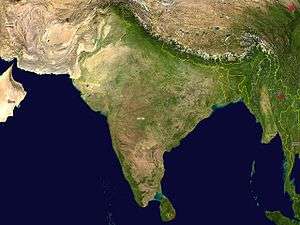Chenab River
| Chenab | |
| River | |
| Country | India, Pakistan |
|---|---|
| Source | Bara Lacha pass |
| - coordinates | 32°38′09″N 77°28′51″E / 32.63583°N 77.48083°E |
| Mouth | Confluence with Sutlej to form the Panjnad River |
| - location | Bahawalpur district, Punjab, Pakistan |
| - coordinates | 29°20′57″N 71°1′41″E / 29.34917°N 71.02806°ECoordinates: 29°20′57″N 71°1′41″E / 29.34917°N 71.02806°E |
| Length | 960 km (597 mi) approx. |
| Discharge | for Akhnoor |
| - average | 800.6 m3/s (28,273 cu ft/s) [1] |
 | |
The Chenab River is a major river of India and Pakistan. It forms in the upper Himalayas in the Lahaul and Spiti district of Himachal Pradesh, India, and flows through the Jammu region of Jammu and Kashmir into the plains of the Punjab, Pakistan. The waters of the Chenab are allocated to Pakistan under the terms of the Indus Waters Treaty.[2][3]
History
The river was known to Indians in the Vedic period[4] as Chandrabhaga (Sanskrit: चंद्रभाग), also Ashkini (Sanskrit: अश्किनि) or Iskmati (Sanskrit: इस्कामति) and as Acesines to the Ancient Greeks.[5] In 325 BC, Alexander the Great allegedly founded the town of Alexandria on the Indus (present day Uch Sharif or Mithankot or Chacharan in Pakistan) at the confluence of the Indus and the combined stream of Punjab rivers (currently known as the Panjnad River).[6]
Image gallery
 Chandra river (shown) is an upper tributary of Chenab.
Chandra river (shown) is an upper tributary of Chenab.
 A view of River Chenab near Gujrat.
A view of River Chenab near Gujrat. A view of Chandrabhagha River through Pangi valley in Himachal Pradesh.
A view of Chandrabhagha River through Pangi valley in Himachal Pradesh.
References
| Wikisource has the text of the 1911 Encyclopædia Britannica article Chenab. |
| Wikimedia Commons has media related to Chenab River. |
- ↑ "Gauging Station - Data Summary". ORNL.
- ↑ "River Chenab" (PDF). Retrieved 2007-06-17.
- ↑ "Indus Waters Treaty". The World Bank. Retrieved 2007-06-17.
- ↑ Yule, Henry; Arthur Coke Burnell; William Crooke. "Hobson-Jobson: A glossary of Anglo-Indian colloquial words & phrases and of kindred terms". Pg.741. Retrieved 2009-05-29.
- ↑ Encyclopædia Britannica article on the Chenab
- ↑ Alexandria (Uch)
